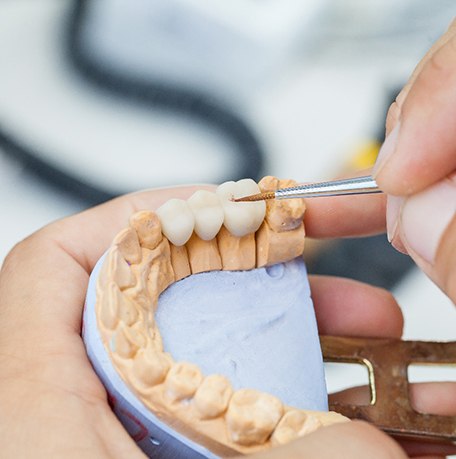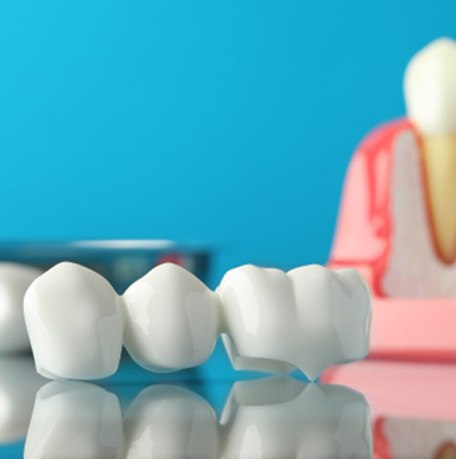Dental Bridges – Soldotna, AK
Closing the Space Between Your Teeth

Have you been struggling with missing one or several teeth in a row? While you aren’t the only one experiencing this situation, you’ll want to seek treatment to replace your pearly whites to avoid oral health complications that come with tooth loss. Fortunately, our team offers dental bridges as the ideal restorations to fill the gaps in your smile. If you want to know if this is a viable treatment for renewing your missing teeth, keep reading or give us a call today to schedule an appointment with our team.
Why Choose Soldotna Dental Arts for Dental Bridges?
- Natural-Looking & Durable Dental Materials
- Personalized & Long-Lasting Restorations
- Performs Entire Implant Placement In-Office
What Is a Dental Bridge?

These restorations are one of the most popular restoration options for renewing missing teeth. Whether you have lost one or multiple ones in a row, a dental bridge can blend seamlessly with the rest of your smile for a natural-looking result. They usually consist of artificial teeth known as pontics that close a gap by being anchored to the healthy teeth on either side of the space.
Types of Dental Bridges

To determine if a dental bridge is a viable solution for you, you’ll need to visit our team for an initial consultation. We will review your dental history and discuss your smile goals to see which type of this treatment would work best for you.
Traditional Dental Bridge
With a traditional dental bridge, your dentist will need to prepare the healthy teeth at the ends of the gap to allow your restoration to fit flawlessly. This typically involves shaving down a tiny amount of your enamel. Afterward, the dental crowns will be fitted atop the two teeth and the pontics will rest against your gumline.
Implant Bridge
Although similar to traditional ones, an implant bridge will be directly anchored to the jawbone via dental implants. Not only will this allow you to avoid removing natural enamel, but you’ll also be able to preserve your youthful facial shape. This solution can also last several decades with minimal dental care.
The Benefits of Getting a Dental Bridge

By getting a dental bridge to close a gap in your smile, you can be sure to appreciate a wide variety of advantages for your new and improved teeth, including:
- Replace one or multiple missing teeth at once
- Maintain the position of your remaining pearly whites
- Personalized results that blend seamlessly with your natural smile
- Easier brushing and flossing for good oral health
- Preserve your jawbone (with an implant bridge)
- Results last 20 years or more with proper care and routine dental visits
Dental Bridges FAQs

Perhaps you’re eager to get a dental bridge. If so, that’s great – you can trust the prosthetic to restore your entire smile. Still, you likely want to address some treatment-related concerns first. Doing so will help you feel confident in your care results. Luckily, Soldotna Dental Arts has you covered: below are some oft-asked dental bridge questions and their answers. By reading them over, you’ll see how the procedure works. If you’d like other details, though, don’t hesitate to call our office!
What are Dental Bridges Made Of?
Generally, dental bridges use the same materials as dental crowns. They can be made from gold, EMAX, zirconia, and porcelain.
In years past, bridges made from gold and other metal alloys were the standard. These kinds are durable and can withstand strong chewing forces. However, they sometimes cause allergies due to their metallic composition.
Today, bridges are more often created from metal-free materials like zirconia and porcelain. The latter substances are tooth-colored and thus blend better with your smile. As such, bridges using them can work as front teeth without drawing attention.
Ultimately, your bridge’s material will depend on your needs. Talk to your dentist to learn what kind they suggest for you.
Is Getting a Dental Bridge Painful?
Rest assured: getting a dental bridge doesn’t hurt. Qualified dentists take steps to ensure the treatment process is smooth and comfortable.
For starters, the dental team will numb your mouth before bridge work. (They’ll use a topical anesthetic to do so.) This approach ensures preparation and placement won’t cause aches. In fact, a dental team can also include sedation at this juncture for nervous patients.
Furthermore, it’s possible to manage any post-treatment soreness. You could take over-the-counter pain relievers or use a cold compress on the affected area. With help from such methods, any discomfort after bridge treatment will quickly fade after a few days.
How Many Teeth Can a Dental Bridge Replace?
Technically, dental bridges can replace anywhere from one to four teeth in a row. That said, most are only used to replace one or two at a time.
You see, bridges become less stable as they extend. (This instability is even greater when the supporting natural teeth aren’t strong or healthy.) Consequently, having a bridge replace three or more teeth is risky. An implant variant can lower the risk, though, since it relies on implants for support instead.
Can Dental Bridges Get Cavities?
No – dental bridges themselves can’t get cavities. After all, they’re artificial and not made of tooth enamel. That means they won’t erode from things like food or bacteria.
Of course, a bridge’s supporting teeth can still develop cavities. Food debris might get trapped beneath the appliance’s crowns, attracting harmful bacteria. From there, acids might wear away the outer tooth layer and create small holes. Thus, you must maintain good oral hygiene, which will keep your bridge’s underside clean and acid-free.

